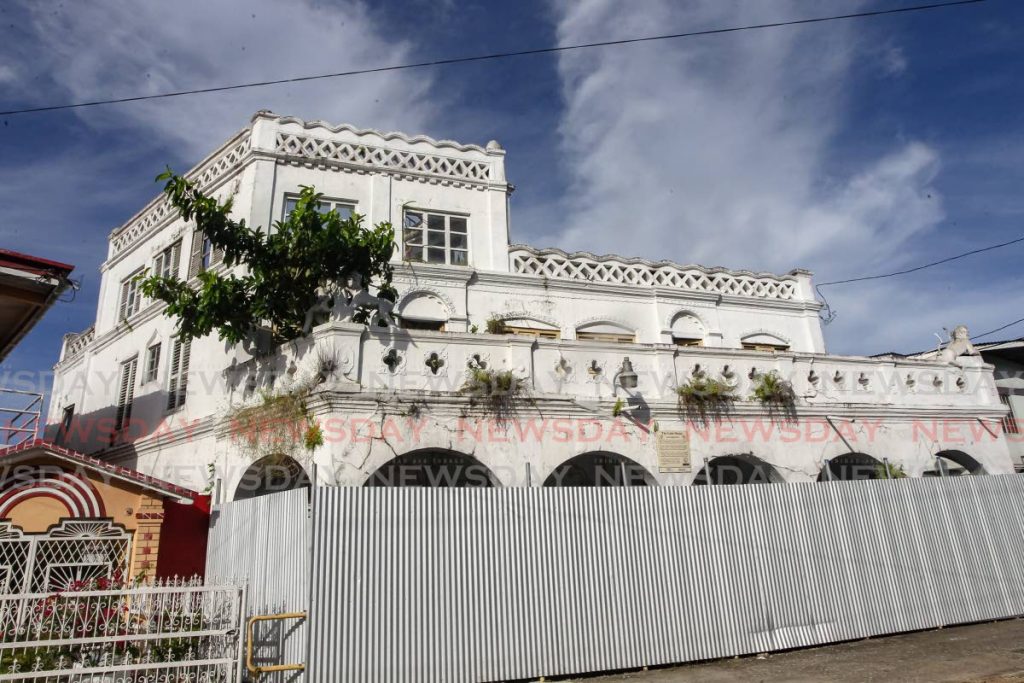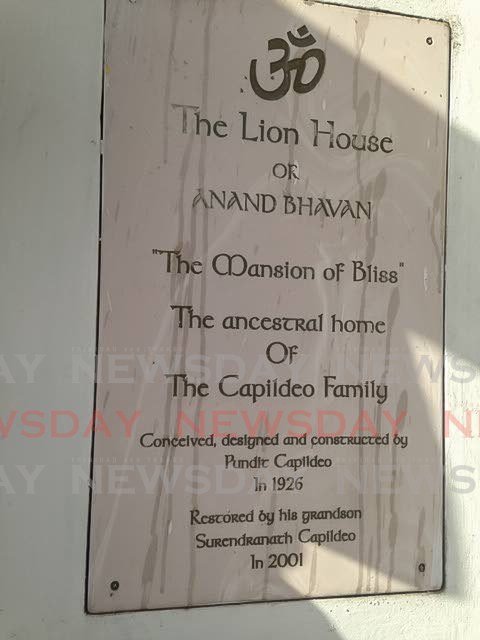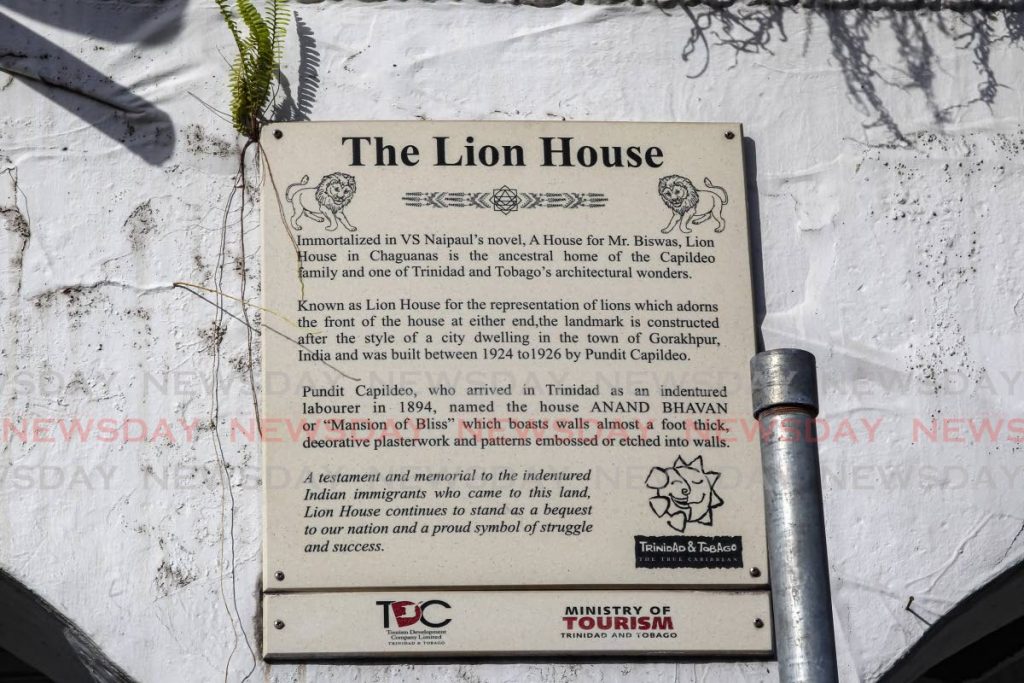Saving the Lion House: a matter of priority

Covered in moss, its white paint faded, the Lion House in Chaguanas is now an eyesore to passers-by.
Its dilapidated condition is now partly concealed behind a galvanised fence. But a large ficus tree above the fence, whose roots are embedded in the building's upper storey, draws attention to just how bad a state it's in.
The Lion House, on the Chaguanas Main Road, not far from the Chaguanas Borough Corporation's offices and the police station, was built by a Pundit Capildeo between 1924 and 1926.
Capildeo, an indentured immigrant, came to Trinidad in September 1894 on the ship Hereford, which sailed from Calcutta with about 597 other indentured immigrants. Somehow, in Trinidad he became a wealthy businessman, landowner and pundit.
The imposing house he built was named Anand Bhavan, which translates as “Mansion of Bliss.”
But it's more commonly known as the Lion House. Perched on the balcony are the lions, which have no religious connotations, but have been described as symbolic guardians of Chaguanas.
More importantly, the building was made famous by a grandson of Capildeo’s – Sir Vidia Naipaul, winner of the Nobel prize in literature and holder of many other accolades for his many books.
His 1961 magnum opus A House for Mr Biswas, a classic of Caribbean and world literature, has as a theme the idea and importance of owning and occupying a home. The struggle to acquire one reflected the story of his own father, Seepersad Naipaul. He and his young family spent some time living at the Lion House with the wealthy relatives of Naipaul's mother, Droapatie Naipaul. The house features in the novel, though with some details altered: it becomes Hanuman House in Arwacas, home of the Tulsi clan.

One of Naipaul's maternal uncles, who lived in the house at that time, was Rudranath Capildeo, leader of the opposition Democratic Labour Party (DLP) from 1960-1969 and the first Leader of the Opposition in the Parliament of the independent TT from 1962-1967. His older brother Simbhoonath was the last Leader of the Opposition in the Legislative Council while TT was still a colony. Rudranath Capildeo was awarded the Trinity Cross, then the nation's highest award, in 1969. He died in 1970. Both brothers appear, satirised and thinly disguised as "the gods," in their nephew's novel.
The National Trust says the house has been earmarked for restoration for over a decade, but this has been hard to do because of legal obstacles.
The National Trust is an NGO set up in 1999 to provide for the legal protection of designated properties, whether built or natural, which are considered important to TT's history. Its jurisdiction over private propery, however, is even more tenuous.
It says the Lion House, has been listed in its Heritage Asset Inventory, which identifies sites considered worthy of national recognition and preservation.
In a media release on October 14, the trust said since March 2019 the owners of the house have been asked for permission to have restoration work done, but to no avail.
It explained, “For work to be carried out on this property which was privately owned legal permission was required for any other organisation or individual to restore it.
“It also meant that the National Trust required formal permission to access the property to create a dossier on the building, which is one of the prerequisites to listing as a Property of Interest.”
Lion House was first passed down, the trust said, to one of Pundit Capildeo’s grandsons, Surendranath Capildeo (Simbhoonath's son), who died in 2016. It is unclear who are the owners of the building now.
The trust said since 1991 there have been attempts at restoration, between 1991 and 1993, and again in 1995. The late architect Colin Laird was retained to advise and supervise the project.
“However, the restoration was incomplete and since then the building has relapsed and deterioration continues.” the National Trust said.
A plaque on the building says Suren Capildeo restored it again in 2001.

The trust said that while it understood and respected the building was private property and the decisions about its future rested with its owners, it still urged intervention.
It was confident, it said, there are patriotic members of the national community and the international diaspora who, with the support of the Chaguanas Borough Corporation, would come forward to help restore the house.
It also said, “The National Trust is committed to provide any expert advice and guidance so that the restoration can be done in an authentic manner. We are hopeful that a way forward can be found to restore this beautiful property and the pride that it inspires in the people of TT.”
A tourist attraction, taken over by homeless people
Former Chaguanas mayor Gopaul Boodan told Sunday Newsday that during his tenure efforts were made to have the house restored, but again legal ownership between the Capildeo and Naipaul families was an obstacle that could not be resolved at the time.
He said, “We tried several times to find out the rightful owner and encourage them to allow the relevant authorities to work on restoration of the house."
(In fact the Naipauls have never been owners or part-owners of the Lion House.)
“Lion House is a great part of Chaguanas, Central and East Indian culture in TT and every effort should be made to preserve it. From far and wide tourists are fascinated with our history and Naipaul’s book. They came to see the house – but there is nothing to show.”
Worse, Boodan said, “The ground floor is now being used by the homeless as a resting place and further destruction to the property is being done.
"I removed them while I was in office, but the situation is now beyond my control.
"I believe Chaguanas as a wide range of history that should be maintained and preserved,”
Messages to the current Chaguanas mayor Faaiq Mohammed on the borough corporation’s plans and whether it will intervene went unanswered. But Mohammed said he understood the urgency of the matter and will respond accordingly, as the matter has grabbed national interest.
Another former Chaguanas mayor, Dr Surujrattan Rambachan, expressed disgust at the condition of the building and said it would soon be lost forever if the owners fail to act.
He said, “The families who are involved in that project are acting very selfishly. I do not think they have an appreciation of what is the value of that particular property to the history of the indentured labourers and the Indian history in TT.
“I think they need to precipitate their own family misgivings towards each other and act in a way that is patriotic to the history of TT. The family needed to come together and lift their vision beyond their narrow familial concerns.”
Rambachan added that during his tenure as mayor and that of Boodan, attempts were made to have work done on the building but legal obstacles and funding impeded them.
And while he acknowledged the efforts of the National Trust, Rambachan said the poor execution of the institution’s purpose and goals had hampered any meaningful work it was set up to carry out.
“The National Trust have not been putting enough effort into doing what they were tasked to do. In this country there are too many people who want to be a head of an organisation, but do not put in the kind of work to preserve these kinds of buildings.
“Projects like these require resources, financial and otherwise, as well as volunteers,” Rambachan said.
The alleged dispute between the owners, Rambachan said, had a great historical cost.
“The country has lost a building where one of our greatest writers was born. We are a country that is laughable when it comes to recognising our achievers.
“In any other part of the world Lion House would have been a like a pilgrimage for literary students. There could have been so many opportunities. Another building could have been opened nearby which could have housed summer students who wanted to study Naipaul. Those students would have been immersed in our and Naipaul’s culture.
“Unfortunately, we have such a limited vision. All we are interested in is the cost of cars and the stupid politics in the country.”
History enthusiast Gerard Besson said the Lion House was especially important to TT history because the descendants of Pundit Capildeo contributed significantly to the country’s development.
“The people who lived in that house actually produced a very interesting group of family members...So the house itself was able to be the home of a family tradition that was dedicated to producing refined minds, to producing exemplary thinkers and remarkable people.”
Besson added that the architecture spoke of a time that should not be forgotten that emphasised and complemented other forms of architectural styles.
The design "went along with the temples and the mosques that were being built by copying the architecture from (Capildeo's) memory which he had of India. It was built from the memory of what a nice, big house in India would look like. It fitted in with the then landscape overall.”
A building, he said, "is like a history book, whether it is brand new or old. The Lion House tells a story, and it should not be destroyed. It is just like the Columbus statue; one does not have to like it or dislike it. But it is part of the history of the place. We can’t create futures by destroying history.
“But it is entirely the Capildeos' and Naipauls' right and privilege to do what they like with their own personal property. The circumstances are within the family and their next step.”
He said TT diverse immigrant groups brought with them and transferred their heritage, cultures and traditions, and those should be maintained.
Editor's note: This story was amended on October 19 to correct the suggestion that the Naipaul family were owners or part-owners of the house.
The name of Surendranath Capildeo's father was also corrected.
From VS Naipaul's A House for Mr Biswas: Among the tumbledown timber-and-corrugated-iron buildings in the High Street at Arwacas, Hanuman House stood like an alien white fortress. The concrete walls looked as thick as they were, and when the narrow doors of the Tulsi Store on the ground floor were closed the House became bulky, impregnable and blank. The side walls were windowless and on the upper two floors the windows were mere slits in the facade. The balustrade which hedged the flat roof was crowned with a concrete statue of the benevolent monkey-god Hanuman...
The facade that promised such an amplitude of space concealed a building which was trapezoid in plan and not deep. There were no windows and light came only from the two narrow doors at the front and the single door at the back which opened on to a covered courtyard. The walls of uneven thickness curved here and jutted there, and the shop abounded in awkward, empty, cobwebbed corners. Awkward too, were the thick ugly columns...


Comments
"Saving the Lion House: a matter of priority"